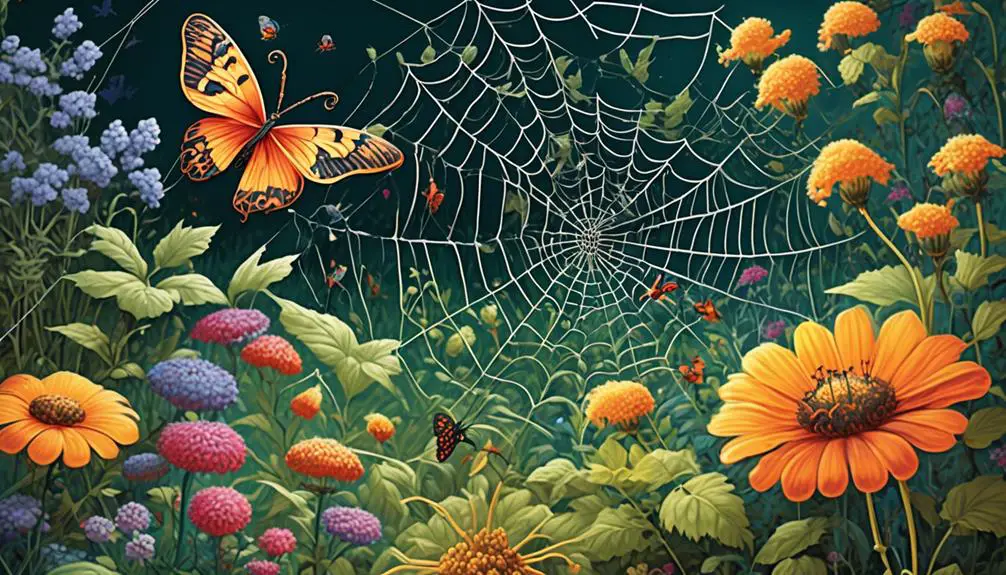Are you ready to uncover the truth about one of nature’s most intriguing mysteries? Brace yourself, because we’re about to reveal whether spiders truly feast on butterflies!
While it may seem like an unlikely pairing, spiders have been known to indulge in these delicate creatures from time to time. However, the story doesn’t end there. There are fascinating factors at play that determine whether or not spiders actually consume butterflies.
Factors such as toxic compounds, hunting strategies, and prey preferences all contribute to the intriguing relationship between spiders and butterflies.
So, if you’ve ever wondered about the intricate dynamics between these two creatures, stay tuned as we unravel the secrets behind their captivating encounters.
Spiders and Monarch Butterflies
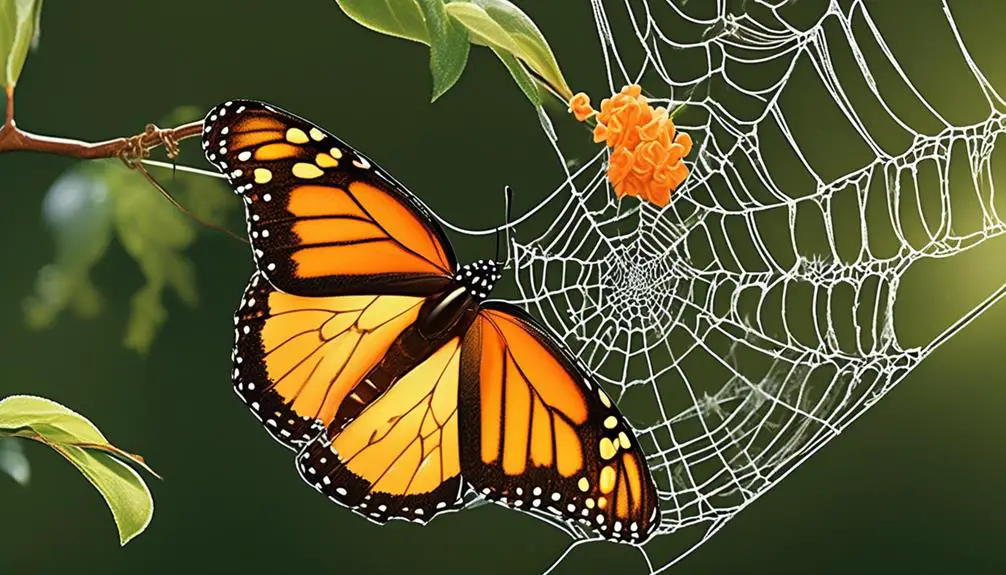
Spiders can discern between male and female monarch butterflies and may be deterred from hunting them due to the toxic compounds found in the butterflies’ bodies. These toxic compounds serve as a defense mechanism for monarch butterflies, making them harmful for spiders to consume. Male monarch butterflies have 30% less poison compared to females, which allows some spiders to avoid the full risk of toxicity. Spiders have the remarkable ability to differentiate between male and female monarch butterflies, possibly through visual or olfactory cues. This ability may play a role in their decision-making process when it comes to hunting prey.
The presence of toxins in monarch butterflies may deter spiders from actively hunting them. When spiders encounter these toxic compounds, they may perceive them as a potential threat and choose to avoid consuming the butterflies. This avoidance behavior could be an adaptive response to protect themselves from the harmful effects of the toxins. By avoiding hunting butterflies that possess these toxic compounds, spiders may increase their chances of survival and minimize the risks associated with ingesting harmful substances.
Further research is needed to fully understand the mechanisms behind spiders’ ability to discern between male and female monarch butterflies and their avoidance of hunting these toxic prey. Scientists are intrigued by the intricate interactions between predators and prey and continue to explore the fascinating world of spider-butterfly dynamics.
Toxic Compound in Monarch Butterflies
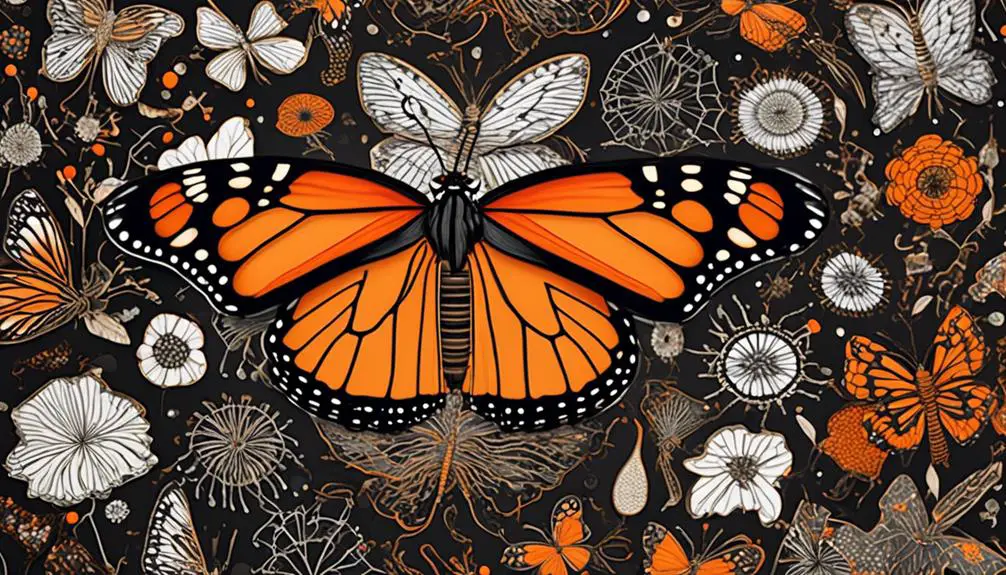
Monarch butterflies possess a toxic compound that deters spiders from consuming them. This compound is called cardiac glycoside, which is found in the milkweed plants that the butterflies feed on during their larval stage. The toxin is stored in their bodies, making them unpalatable and potentially lethal to predators like spiders.
When spiders encounter monarch butterflies, they may recognize the presence of the toxic compound through visual or chemical cues. This recognition allows spiders to avoid consuming the butterflies and seek alternative prey. Studies have shown that male monarch butterflies have a lower concentration of toxins compared to females, which may allow some spiders to tolerate or avoid the full risk of toxicity.
The toxic compound in monarch butterflies acts as a defense mechanism, deterring potential predators from hunting them. Spiders, being carnivorous and opportunistic, are constantly searching for suitable prey. However, when they encounter monarch butterflies, the presence of the toxic compound may discourage them from pursuing a potential meal.
Male Monarch Butterflies and Spider Avoidance
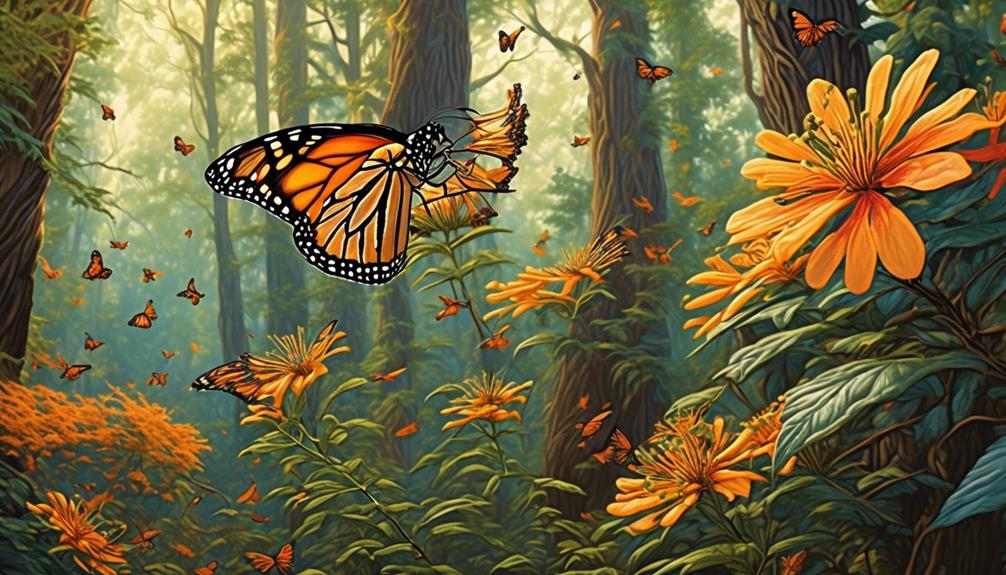
Male monarch butterflies play a role in spider avoidance due to their reduced toxicity. Their lower poison levels compared to females allow some spiders to minimize the risk of consuming toxic prey.
Spiders have the ability to differentiate between male and female monarch butterflies, potentially influencing their hunting behavior and prey selection.
Male Monarch Defense
With 30% less poison compared to females, male monarch butterflies have developed a defense mechanism that allows them to elude the full risk of toxicity and avoid the attention of certain spiders. This reduced toxicity makes male monarch butterflies less attractive to spiders as prey. Spiders are able to differentiate between male and female monarch butterflies, and they may actively avoid males due to their lower toxin levels.
The toxins present in monarch butterflies act as a deterrent for spiders, making them less likely to hunt these butterflies. By avoiding the attention of spiders, male monarch butterflies increase their chances of survival and reproduction. This defense mechanism showcases the adaptability and evolutionary strategies employed by male monarch butterflies in their interaction with spiders.
Spider Toxicity Detection
Spiders possess the ability to detect and respond to the toxic compounds present in monarch butterflies, which influences their decision to avoid hunting them. Male monarch butterflies have 30% less poison compared to females, allowing some spiders to avoid the full risk of toxicity. Spiders can differentiate between male and female monarch butterflies. The table below summarizes the spider toxicity detection abilities:
| Spider Toxicity Detection |
|---|
| Spiders can detect and respond to toxic compounds in monarch butterflies |
| Male monarch butterflies have less poison, making them less toxic for spiders |
| Spiders can differentiate between male and female monarch butterflies |
This ability to detect toxicity allows spiders to make informed decisions about their prey, helping them avoid potential harm. By recognizing the toxic compounds in butterflies, spiders can prioritize other prey options that do not pose the same risks.
Spiders and Butterfly Deterrence
Butterfly deterrence in spiders is influenced by the presence of male monarch butterflies and their ability to avoid spider predation. Male monarch butterflies have been found to contain 30% less toxic compounds compared to females, allowing some spiders to avoid the full risk of toxicity.
Spiders have the ability to differentiate between male and female monarch butterflies, possibly due to visual cues or chemical signals. The toxins present in monarch butterflies may deter spiders from hunting them, as spiders rely on their hunting instincts and don’t consume dead butterflies.
However, if the toxins released by the butterflies don’t deter the spiders, they’ll consume them as part of their wide range of prey choices.
Further research is needed to understand the specific mechanisms behind spider deterrence and butterfly avoidance.
Spiders’ Ability to Differentiate Between Male and Female Monarch Butterflies
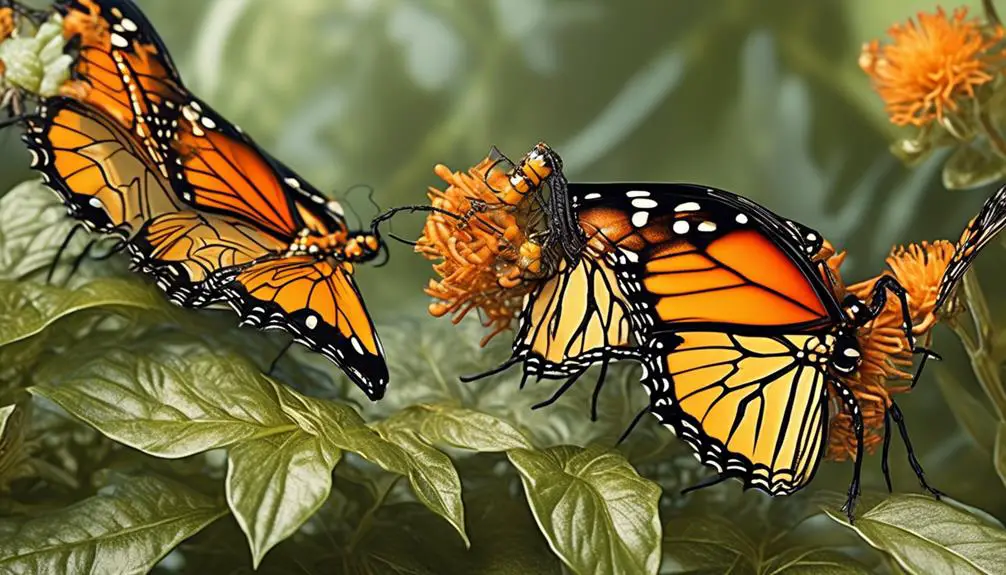
Male and female monarch butterflies can be distinguished by spiders due to their ability to detect variations in the levels of toxic compounds present in their bodies. Monarch butterflies contain a toxic compound that makes them harmful for spiders to consume. However, male monarch butterflies have 30% less poison compared to females, allowing some spiders to avoid the full risk of toxicity. Spiders have the capability to recognize and differentiate between the sexes of monarch butterflies based on the differences in the toxic compounds they possess. This ability allows spiders to make a decision on whether or not to pursue a particular butterfly as prey.
The ability of spiders to differentiate between male and female monarch butterflies is an important adaptation. By avoiding the more toxic females, spiders can reduce the potential harm they may experience from consuming the butterflies. This ability may be crucial for the survival and successful hunting of spiders in areas where monarch butterflies are present.
Further research is needed to understand the exact mechanisms by which spiders detect and differentiate between male and female monarch butterflies. By studying this phenomenon, scientists can gain insights into the complex interactions between predators and prey in natural ecosystems.
Monarch Butterflies as Deterrents for Spiders

The ability of spiders to differentiate between male and female monarch butterflies based on variations in toxic compounds leads to an interesting phenomenon in their hunting behavior. Male monarch butterflies have 30% less poison compared to females, allowing some spiders to avoid the full risk of toxicity. This ability to discern between the sexes may influence the spiders’ decision to hunt or not hunt these butterflies.
Monarch butterflies contain a toxic compound that makes them harmful for spiders to consume. The toxins released by these butterflies may act as a deterrent for spiders, preventing them from hunting. The spiders may recognize the presence of these toxins and decide to avoid the butterflies altogether.
Spiders are opportunistic predators and will catch butterflies whenever they have the chance. However, if the toxins released by the butterflies are strong enough, spiders may be deterred from hunting them. The spiders may recognize the potential danger and choose to focus their attention on other prey that doesn’t pose such risks.
Spiders’ Preference for Catching Butterflies in Certain Times of the Day
Spiders exhibit a distinct preference for catching butterflies during specific times of the day. They’re more likely to catch butterflies in the mornings or evenings when the temperature is cooler. This is because butterflies need warm muscles to fly, and the cold environment during these times can freeze and paralyze them temporarily. Spiders take advantage of the paralyzed butterflies to catch them more easily. Additionally, the cold temperatures make it difficult for butterflies to escape from spider webs.
Spiders are opportunistic hunters and will catch butterflies whenever they have the chance. However, it’s important to note that spiders don’t scavenge and only eat butterflies that they’ve caught in their webs. Dead butterflies are typically eaten by scavengers like mice or rats. Spiders rely on their hunting instincts and don’t consume dead butterflies. Therefore, spiders prefer to catch live butterflies rather than feeding on dead ones.
Spiders are carnivorous and can eat any kind of insect, including butterflies. There’s no record of spiders avoiding butterflies as prey. However, spiders may be deterred from hunting butterflies if the toxins released by the butterflies deter them. Spiders will consume butterflies if the toxins don’t deter them. Additionally, spiders can eat butterflies that are much larger than themselves. Even if a large butterfly is trapped in a spider’s web, the spider will consume it.
Paralyzing Effect of Cold Temperatures on Butterflies
During the cooler times of the day, when butterflies’ warm muscles become susceptible to freezing, spiders take advantage of this vulnerability to catch their prey more easily. Butterflies need warm muscles to fly, but the cold environment during these times can freeze and paralyze them temporarily. Spiders have adapted to this by positioning themselves strategically to capture the paralyzed butterflies. They construct intricate webs that act as traps, waiting for the perfect moment to strike.
To understand the paralyzing effect of cold temperatures on butterflies, let’s take a closer look at the process:
| Column 1 | Column 2 | Column 3 |
|---|---|---|
| Time of Day | Butterfly Vulnerability | Spider Strategy |
| Mornings | Butterflies are sluggish and have lower body temperatures, making them more susceptible to freezing. | Spiders position themselves near butterfly feeding grounds, ready to pounce on their paralyzed prey. |
| Evenings | Butterflies’ body temperatures drop as the day cools down, rendering them more vulnerable to freezing. | Spiders wait patiently near butterfly roosting spots, where they can easily catch paralyzed butterflies. |
During these times, spiders have a higher chance of successfully capturing butterflies. The cold temperatures make it difficult for butterflies to escape from spider webs, increasing their vulnerability. Spiders, being opportunistic predators, take full advantage of this situation.
Spiders’ Opportunistic Nature in Catching Butterflies
Spiders’ opportunistic nature allows them to take advantage of the perfect timing and conditions to catch butterflies. When butterflies are vulnerable, spiders seize the opportunity to capture them. Butterflies are more likely to be caught in the mornings or evenings when the cold temperatures temporarily paralyze them.
Spiders exploit this weakness and use their webs to capture the immobilized butterflies. The cold environment makes it difficult for the butterflies to escape, increasing the chances of them becoming trapped in the spider’s web. Spiders aren’t deterred by the size of the butterflies they encounter; they can consume butterflies much larger than themselves. Although spiders may avoid getting too close to live butterflies, they’ll not hesitate to devour them once they’re dead.
Spiders’ hunting instincts drive them to catch any kind of insect, including butterflies. Their opportunistic nature allows them to take advantage of the availability of butterflies as prey.
Spiders’ Limited Interest in Dead Butterflies
Spiders, being carnivorous creatures, have a limited interest in dead butterflies. Their hunting instincts drive them to prefer live prey that they can actively pursue and capture themselves.
Dead butterflies aren’t suitable food for spiders, as they rely on their own efforts to catch and kill their prey.
Scavenging Behavior Explained
Spiders exhibit a limited interest in dead butterflies, as they primarily rely on their hunting instincts and prefer to consume prey that they’ve killed themselves. Spiders are opportunistic predators that actively hunt for their food. They use their webs or stealthy movements to catch live prey, such as flies, mosquitoes, and other insects.
Dead butterflies, on the other hand, don’t elicit the same response from spiders. Spiders don’t scavenge for food and generally don’t consume dead butterflies. Instead, scavengers like mice or rats are more likely to feed on dead butterflies.
Spiders have evolved to rely on their hunting skills, targeting live prey that they can immobilize and inject with venom. This behavior ensures that spiders obtain fresh, uncontaminated food sources and maintain their survival and reproductive success.
Spiders Prefer Live Prey
When it comes to their feeding habits, spiders exhibit a distinct preference for live prey, showing limited interest in dead butterflies. Spiders rely on their hunting instincts and don’t scavenge for food. Dead butterflies are typically consumed by scavengers like mice or rats.
Spiders only eat prey that they’ve caught themselves. They don’t consume dead butterflies, as they aren’t suitable food for spiders. Instead, spiders actively hunt and catch live butterflies, taking advantage of opportunities when they arise. Spiders are carnivorous and can eat any kind of insect, including butterflies.
However, if the toxins released by butterflies deter the spiders, they may choose to avoid hunting them. Nonetheless, once a butterfly is dead and no longer a threat, spiders will devour it without hesitation.
Spiders’ Carnivorous Nature and Prey Choices
Carnivorous by nature, spiders have a wide array of prey choices, including butterflies. Spiders are opportunistic hunters and will catch butterflies whenever they have the chance. They aren’t known to avoid butterflies as prey. However, the consumption of butterflies by spiders may be influenced by certain factors.
One such factor is the toxic compound found in monarch butterflies. These toxins make them harmful for spiders to consume. Male monarch butterflies have 30% less poison compared to females, allowing some spiders to avoid the full risk of toxicity. Spiders can also differentiate between male and female monarch butterflies. The toxins released by monarch butterflies may deter spiders from hunting them. Spiders may not consume butterflies if the toxins released by them deter the spiders.
Spiders are more likely to catch butterflies in the mornings or evenings when the cold environment can freeze and paralyze them temporarily. The cold temperatures make it difficult for butterflies to escape from spider webs, and spiders take advantage of this to catch them more easily. Even if a large butterfly is trapped in a spider’s web, the spider will consume it. Spiders can eat butterflies that are much larger than themselves.
However, it’s important to note that spiders don’t scavenge and only eat butterflies caught in their webs. Dead butterflies are typically eaten by scavengers like mice or rats. Spiders rely on their hunting instincts and don’t consume dead butterflies. Therefore, while spiders have a wide range of prey choices, including butterflies, they prefer to consume live prey and don’t eat dead butterflies.
Potential Deterrence of Butterfly Toxins on Spider Hunting
The presence of toxins released by monarch butterflies may potentially deter spiders from actively hunting and consuming them. Monarch butterflies contain a toxic compound that makes them harmful for spiders to consume. The toxins present in monarch butterflies act as a deterrent for spiders, as they can have adverse effects on the spiders’ health and survival. Female monarch butterflies possess a higher concentration of toxins compared to males, making them particularly unappealing for spiders.
However, some spiders can differentiate between male and female monarch butterflies and may still attempt to hunt the less toxic males. Despite this, the overall toxic nature of monarch butterflies may discourage spiders from actively seeking them as prey. Spiders are opportunistic hunters and will catch butterflies whenever they’ve the chance, but the potential toxicity of monarch butterflies may make them less desirable prey.
Further research is needed to understand the specific mechanisms by which spider hunting is deterred by the toxins present in monarch butterflies.
Spiders’ Ability to Consume Larger Butterflies
Spiders possess the remarkable ability to consume butterflies that are significantly larger than themselves. Despite their small size, spiders are equipped with specialized adaptations that enable them to capture and devour these larger prey. When a large butterfly becomes trapped in a spider’s web, the spider will seize the opportunity to feed on it. Although spiders may initially avoid getting too close to live butterflies due to their toxins, once the butterfly is immobilized or dead, the spider will readily consume it.
One reason spiders can consume larger butterflies is their ability to spin strong and intricate webs. These webs are designed to ensnare and immobilize prey, allowing the spider to approach and inject venom, which paralyzes the prey and begins the digestion process. The spider’s sharp fangs and venomous bite are adapted to penetrate the butterfly’s exoskeleton, enabling the spider to extract nutrients from the prey’s body.
Additionally, spiders are opportunistic hunters, taking advantage of any available food source. This includes butterflies that are larger than themselves. The spider’s instinctual drive to feed, coupled with its ability to overpower and consume larger prey, allows it to maximize its chances of survival and successful reproduction.
Spiders’ Consumption of Trapped and Dead Butterflies
When it comes to trapped butterflies, spiders are known to consume them as part of their natural predatory behavior. Spiders take advantage of butterflies that are paralyzed and unable to escape from their webs, making them easy prey.
However, once a butterfly is dead, spiders typically don’t consume it, as they rely on their hunting instincts and prefer to eat prey that they’ve killed themselves.
Trapped Butterfly Consumption
Trapped in the intricacies of spider webs, butterflies become vulnerable prey for the arachnids. Once ensnared, spiders have the opportunity to consume their trapped butterfly prey. However, it is important to note that spiders do not scavenge and only eat butterflies that they have caught themselves. Dead butterflies, which are typically eaten by scavengers like mice or rats, are not suitable food for spiders. Spiders rely on their hunting instincts and prefer fresh prey. In fact, spiders have a wide range of prey choices, including butterflies. Even if a butterfly is much larger than the spider itself, once it becomes trapped and unable to escape from the web, the spider will consume it. The table below summarizes the consumption behavior of spiders towards trapped and dead butterflies.
| Behavior | Description |
|---|---|
| Trapped Butterfly Consumption | Spiders will consume butterflies that become trapped in their webs. |
| Dead Butterfly Consumption | Spiders do not consume dead butterflies and leave them to scavengers. |
Spiders are opportunistic predators and will take advantage of any trapped butterfly they encounter in their webs. However, once the butterfly is dead, it becomes suitable food for the spider.
Spiders and Paralyzed Butterflies
After ensnaring a butterfly in its intricate web, the spider seizes the opportunity to consume its paralyzed prey. When butterflies are caught in spider webs, they may become temporarily paralyzed due to the cold temperatures during the mornings or evenings when spiders are more likely to catch them. The cold environment can freeze and immobilize the butterflies, making it difficult for them to escape.
Spiders take advantage of this paralysis to more easily capture and consume their prey. However, it’s important to note that spiders don’t scavenge and only eat butterflies that they’ve caught themselves. Dead butterflies are typically eaten by scavengers like mice or rats, as spiders rely on their hunting instincts and don’t consume dead prey.
Spider’s Aversion to Dead Butterflies
Spiders don’t have an aversion to dead butterflies and will consume them if they’ve the opportunity. Although spiders primarily catch live prey in their webs, they don’t scavenge for dead butterflies. Instead, dead butterflies are typically eaten by scavengers like mice or rats.
Spiders rely on their hunting instincts and prefer to consume prey that they’ve killed themselves. Dead butterflies aren’t suitable food for spiders, as they require fresh prey to meet their nutritional needs. However, if a spider catches a live butterfly in its web and it eventually dies, the spider won’t hesitate to devour it.
Spiders are opportunistic predators and will take advantage of any available food source, including dead butterflies.

Erzsebet Frey (Eli Frey) is an ecologist and online entrepreneur with a Master of Science in Ecology from the University of Belgrade. Originally from Serbia, she has lived in Sri Lanka since 2017. Eli has worked internationally in countries like Oman, Brazil, Germany, and Sri Lanka. In 2018, she expanded into SEO and blogging, completing courses from UC Davis and Edinburgh. Eli has founded multiple websites focused on biology, ecology, environmental science, sustainable and simple living, and outdoor activities. She enjoys creating nature and simple living videos on YouTube and participates in speleology, diving, and hiking.

